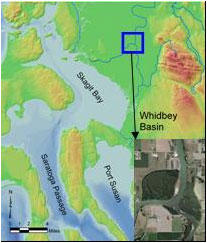SSM Habitat Restoration: Cottonwood Island
Cottonwood Island Restoration Feasibility Study, Washington

Cottonwood Island is located near the bifurcation of the Skagit River into its North and the South Forks, approximately 10 river miles upstream from the mouth of the river. This area is a riverine tidal and floodplain forest zone that is influenced by tide and is periodically inundated by flooding events. Historically, the Skagit River meandered around the west side of Cottonwood Island. However, in 1889, the existing levee was relocated to the present alignment. This constrained flow and developed a complex cut-off channel to form the present river. Consequently, the old west channel was blocked because of sedimentation at the head of the channel, and in its current state, it does not allow flow to pass when the river is low.

The Skagit Watershed Council and its project partners, including Seattle City Light and the Washington State Department of Natural Resources, evaluated the feasibility of restoring the historic connection around Cottonwood Island such that the fish have access to refuge in the west channel habitat. Proposed restoration actions included dike setback and channel dredging to maintain the functioning of fish habitat in the west channel around Cottonwood Island. Battelle conducted a hydrodynamic and sediment transport modeling analysis as part of the restoration feasibility study. The overall objective of the study was to evaluate whether the proposed restoration of Cottonwood Island is feasible with respect to hydrodynamic and sediment-transport impacts at the restoration site. For this study, a three-dimensional hydrodynamic model was developed for the Cottonwood Island restoration site using the Finite Volume Coastal Ocean Model. The model was calibrated with field-observed tide, current, and salinity data. The wetting and drying process in the Cottonwood Island and the overbank region was successfully simulated in the model. The calibrated model was then used to simulate flood inundation, velocity distribution, and sedimentation in the study area for the existing conditions as well as for the restoration alternatives.
Project Highlights
- Simulations showed that Cottonwood Island is partially or completely inundated by the 10-year and 25-year flood flow. Under average- and low-flow conditions, the west channel remained dry.
- Tidal inundation in the large tidal flats region in the bay and estuary mouth was successfully simulated using the wetting/drying feature of the model.
- The selected alternative design requiring some dredging provides the most benefits in terms of restoration cost. It is especially attractive because it does not require a dike setback. It also reduces the sedimentation at the entrance of west channel relative to other alternatives.
- The results indicate that the west channel may be successfully restored in habitat functionality with respect to flow connectivity at low-flow conditions by dredging the channel up to an optimal elevation for juvenile fish habitat, just below the low-water level.
Contacts and Project Team
- PNNL: Tarang Khangaonkar (CO-PI), Cheegwan Lee (CO-PI)
- Skagit Wateshed Council: Shirley Solomon
Study Reports and Publications
Lee C and T Khangaonkar. 2007. Cottonwood Island Restoration Feasibility Study - Hydrodynamic and Sediment Transport Analysis. PNWD-3880, prepared for Skagit Watershed Council, by Battelle, Pacific Northwest Division, Richland, WA.
Lee C, T Khangaonkar and Z Yang. 2007. Application of Hydrodynamic and Sediment Transport Model for the Restoration Feasibility Assessment - Cottonwood Island, Washington. In Proceedings of 10th International Conference on Estuarine and Coastal Modeling, American Society of Civil Engineers, Newport, RI.